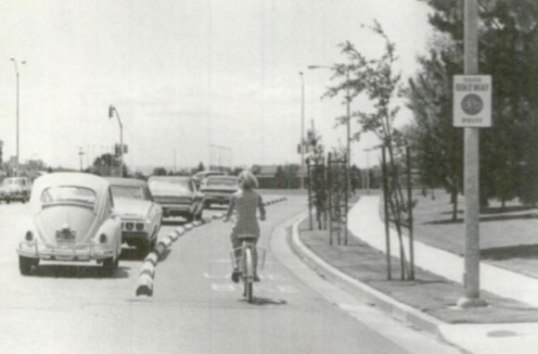Bike Battles

- Author James Longhurst. (Photo: Rory O’Driscoll, LaCrosse Tribune).
Bike Battles, a new history of bike culture in the US by UW-LaCrosse history professor James Longhurst (University of Washington Press, 2015), tells the fascinating story of the legal and political battles over bicycles on the road. Subtitled “A History of Sharing the American Road,” the book provides a background to today’s arguments over bike lanes, sharing the road, road diets, complete streets, and so on. Viewing the road as a commons, a shared, limited, and necessary resource, he provides a detailed account of how this public resource came to be dominated and virtually monopolized in the mid-20th century by one user—the driver of the private automobile. The outcome was neither inevitable, nor, as some might assume, primarily the result of Americans’ mythic “love affair” with the car or of free consumer choice. It was the result of a complex interplay between public policy choices, law, design choices, the economics of road-building, and cultural shifts in the perception and marketing of the bicycle. Longhurst’s book will be useful to anyone interested in the history of bike policy and roads in the US. As Peter Norton’s Fighting Traffic shows how motor vehicle interests (“motordom”) marginalized pedestrians, Longhurst’s book illustrates how bicyclists were also marginalized.
Longhurst’s history of roads combines information that I was familiar with, such as the “good roads” movement that was originally spearheaded by bicyclists during the so-called “golden age” of cycling (ca. 1880-1910), with much new information that I was less familiar with. For example, he highlights the importance of Taylor v. Goodwin, an 1879 court case in Britain involving a high-wheel bicycle that established the bicycle as a legal vehicle with a right to the road. The Taylor decision provided an important precedent subsequently followed by American courts. However, case law establishing that bicycles had the same right to the road as other vehicles did not end conflict over road space, especially as the motor vehicle created a new set of conflicts on the road, and a new level of potential deadliness to other road users.

Sidepath, New York, ca. 1900. (People for Bikes)
With the emergence of the automobile it became clear that some form of physical separation between bikes and cars was desirable, and there was a brief period when “side paths” for bicycles were built along many roads. The perception of bicycling as an elite activity made separate infrastructure seem like a luxury for the benefit of a relative few and bicycle advocates failed to secure a steady source of funding for building and maintaining sidepaths. Unfortunately, lack of funding doomed these promising efforts and the experiment was abandoned as the miles of sidepaths that existed were simply swallowed by roads that were widened for the automobile. As the first bicycle boom ended in the 1920s, policymakers gave little thought to providing road space for bikes, and, except for a brief resurgence of bicycling during World War II, bikes gradually came to be marketed in mid-20th century American culture as primarily a means of mobility for kids until they were old enough to drive.

Protected bike lane, 1970s, Davis, CA (Streetsblog)
The next effort to build separated bike infrastructure in the US occurred during the second “bike boom” of the 1970s. Longhurst analyzes the boom within the context of the rise in environmental consciousness in the early 1970s combined with the Mideast oil embargo. These, along with reduced tariffs on lightweight, inexpensive Japanese-made bikes and components contributed to the boom in adult cycling. California became the epicenter of innovative ideas for separated and protected bike lanes in the US. Davis, California was among the first US cities to build separated bike lanes, and the university town became a model for bike-friendliness, a distinction it holds to this day. Planners from UC Davis and UCLA wrote a groundbreaking study in 1972 that advocated the building of networks of separated bike lanes throughout the US where automobile traffic was heavy. Longhurst notes that the California legislature passed a bill in 1973 to permanently earmark 1 percent of the state’s gas tax revenue to build bicycling infrastructure. Things looked promising, but Ronald Reagan’s veto of the bike bill and a schism in the ranks of bicyclists between planners and “vehicular cyclists” who opposed separating cyclists from traffic thwarted plans for separated bike infrastructure of the kind called for by the UCLA study. Yet another missed opportunity.

Cycle Track, Washington DC, 2014 (Bethesda Magazine)
Today, in many cities around the world, we are witnessing a bicycling “renaissance.” Along with this renaissance there is a renewed effort to establish separated road space for cyclists in the United States. Longhurst’s timely study shows that the arguments over bikes and road space are not new and also holds lessons for present-day bicycle advocates who would be wise to avoid the mistakes that scuttled earlier efforts to build bike infrastructure in US cities.
Unlike the two earlier bike booms, this one seems to have a broader constituency and, one hopes, more stable funding. Urban planners understand the need for multimodal commuting as we grapple with the interconnected problems of traffic congestion, sprawl, and climate change. Public health advocates increasingly see “active transportation” as a public good, and the bicycling movement shows healthy signs of diversifying, spreading beyond recreational cycling and emphasizing the social equity aspect of bikes as economical transportation. A growing number of people are realizing that a reallocation of road space will be necessary (though one must not underestimate the tenacity of drivers’ opposition). One hopes that the current efforts to build world class bike infrastructure in the US will not fall victim to the fate that befell the two earlier efforts. As Longhurst concludes: “[i]n the future, more than ever, we’ll need to share the road.” (p. 241)